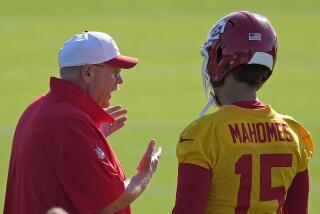This Year Marks the Beginning of NFL’s Moving Van Era
- Share via
This week in the NFL, the Raiders play host to the Cowboys in a possible Super Bowl preview, the Chargers attempt to keep their flagging playoff hopes alive against the Broncos, the Lions and the Bears resume an age-old Black & Blue Division rivalry at Soldier Field and Oilers announce their intention to move from Houston to Nashville.
Last week in the NFL, the 49ers stunned the Cowboys in a possible NFC championship game preview, Dan Marino broke Fran Tarkenton’s record for career passing yardage, Brett Favre tied a Packer record by throwing for five touchdowns against the Bears and the Browns announced their intention to move from Cleveland to Baltimore.
Next week, the Chiefs and the Cowboys play on Thanksgiving, the Rams and the 49ers meet again, the Raiders and the Chargers meet again and, if all goes according to form, the Bengals announce their attention to move from Cincinnati to Orlando, or Memphis, or San Antonio, or any other poor city lacking so severely in the self-esteem department that it feels $250 million is a reasonable price to pay for “major league” status.
I can’t wait for next year’s installments of those classic AFC Central neighborhood feuds.
Nashville at Baltimore.
Orlando at Jacksonville.
Pittsburgh at . . . what’s a rust-corroded old town like Pittsburgh doing among all these progressive, can-do, will-spend, never-mind-the-public-services post-modern thinkers?
Pittsburgh is old hat, old school, out of date, past its time, hopelessly antiquated.
Pittsburgh actually played NFL football before 1995.
That will be the cutoff year, too.
Before 1995 and After 1995.
Or, to speak in terms of Eras, as professional football writers and commissioners are wont to do:
1950-1965: The Golden Era.
1966-1994: The Super Bowl Era.
1995-on: The Bekins Era.
Historians will blame the Bekins Era on Paul Tagliabue, much the same way they credited Pete Rozelle for the NFL’s boom period--the AFL-NFL merger; Monday Night Football; the creation of a holiday, Super Sunday, that has blown past the Fourth of July and is closing in on Christmas in the Great American Tradition Division.
Rozelle is remembered as a man of vision and foresight, who masterminded pro football’s overtaking of baseball as the national pastime, incredibly, with no assistance whatsoever from Bud Selig and Donald Fehr. Tagliabue will be remembered as the man who gave us the Baltimore Browns and the Nashville Oilers.
But is that fair?
As Tagliabue readily concedes, this intense game of franchise hopscotch is being played several levels above his head. If Tagliabue wanted to keep the Browns in Cleveland or the Rams out of St. Louis, he’d have needed the backing of the courts. And as Al Davis can recite from the memory, the NFL is about 0-for-the-20th-century in these block-that-franchise-shift court cases.
Tagliabue is more like a lifeguard on a Carolina beach the day Hurricane Hugo hits. Disaster occurred during his watch, but, really, what could he have done to prevent it?
John Shaw, however, doesn’t get off so easily. (Not that he minds in the least.) In fact, the NFL of the Nashville Oilers and the Oakland Raiders Part Deux isn’t so much John Tagliabue’s NFL as it is John Shaw’s NFL.
It was Shaw who found a legal way to charge fans for the same ticket twice; who introduced NFL owners to their new best friend, Mr. Personal Seat License; who dribbled droplets of acid onto a stadium lease previously thought to be impermeable; who approached problematic swatches of small print the same way Barry Sanders approaches a cornerback; who showed owners and team presidents throughout the league how to uproot a 50-year local institution and move it to another time zone without troubling your conscience one whit.
(Basically, Shaw demonstrated, this can be done by placing your conscience on irrevocable waivers. Al Davis caught on very quickly. Art Modell, still a tad old-fashioned, required several more months.)
Shaw was Christopher Columbus, Johnny Appleseed, Lewis and/or Clark. He got the moving-van convoy rolling by taking the first brazen step in late 1993, put the hapless Anaheim Rams up for auction to the highest bidder and actually had a half-dozen of the country’s largest cities falling over themselves to claim the mantle of “Home of the Rams, Losingest Team in the NFL Since 1989.”
If Shaw could do this with Rams, imagine what could be done with a couple of good teams--the Raiders, say, or the Browns.
Now, look: Four NFL teams within a span of seven months have either changed cities or signed papers to do so before the 1996 season. The Bengals are on deck. The Seahawks have grabbed a bat and the pine tar rag. Down there on the bench, the Buccaneers are always a threat.
The NFL has become a bus station. Teams come, teams go and all the while, fans get taken for a ride.
Welcome to John Shaw’s NFL. But don’t stay long.
Nobody around here ever does.
More to Read
Go beyond the scoreboard
Get the latest on L.A.'s teams in the daily Sports Report newsletter.
You may occasionally receive promotional content from the Los Angeles Times.










